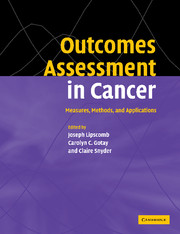Book contents
- Frontmatter
- Contents
- List of contributors
- Acknowledgments
- 1 Introduction to Outcomes Assessment in Cancer
- Health-related quality of life in cancer: general concepts and generic measures
- Assessing health-related quality of life during treatment
- 5 Quality of life in breast cancer: what have we learned and where do we go from here?
- 6 Measuring quality of life in prostate cancer: progress and challenges
- 7 The science of quality-of-life measurement in lung cancer
- 8 Treatment for colorectal cancer: impact on health-related quality of life
- 9 Instruments to measure the specific health impact of surgery, radiation, and chemotherapy on cancer patients
- Assessing health-related quality of life across the cancer continuum
- Measuring the experience and needs of cancer patients and caregivers
- Methodological considerations in applications to cancer outcomes research
- Modern psychometric theory in cancer outcomes research
- Assessing the economic impact of cancer
- Research and policy implications
- Invited papers
- Index
- References
9 - Instruments to measure the specific health impact of surgery, radiation, and chemotherapy on cancer patients
Published online by Cambridge University Press: 18 December 2009
- Frontmatter
- Contents
- List of contributors
- Acknowledgments
- 1 Introduction to Outcomes Assessment in Cancer
- Health-related quality of life in cancer: general concepts and generic measures
- Assessing health-related quality of life during treatment
- 5 Quality of life in breast cancer: what have we learned and where do we go from here?
- 6 Measuring quality of life in prostate cancer: progress and challenges
- 7 The science of quality-of-life measurement in lung cancer
- 8 Treatment for colorectal cancer: impact on health-related quality of life
- 9 Instruments to measure the specific health impact of surgery, radiation, and chemotherapy on cancer patients
- Assessing health-related quality of life across the cancer continuum
- Measuring the experience and needs of cancer patients and caregivers
- Methodological considerations in applications to cancer outcomes research
- Modern psychometric theory in cancer outcomes research
- Assessing the economic impact of cancer
- Research and policy implications
- Invited papers
- Index
- References
Summary
Introduction
Surgery, radiation, and chemotherapy are used to cure, to prolong life, and to palliate symptoms of cancer patients. These treatments can have complicated effects on the patients who receive them. Their therapeutic effects on the cancers are intended to preserve or improve health status over time. However, these therapies can cause short-term and long-term adverse effects that result in deterioration in health status.– Prescribing these treatments requires a careful assessment of the risks and benefits of the proposed therapy by both the treating physician and patient. In situations where the benefits are curing the disease and the risks are minimal, treatment decisions are straightforward. Conversely, in situations where benefits are marginal, such as modest improvements in survival or palliation of symptoms, and the risks include treatment-related morbidity, treatment decisions are more difficult. If the fundamental question to be addressed by health care professionals and patients before prescribing treatment is “Does the toxicity and/or the inconvenience of the proposed treatment justify the expected gain?” then providing data on the impact of therapy on patient health from carefully conducted clinical studies, using robust instruments designed to assess impact of treatment-related morbidities specifically, could provide useful information. The purpose of this chapter is to review the treatment-specific instruments that have been developed and discuss their potential role in assessing the impact of therapy on cancer patients.
- Type
- Chapter
- Information
- Outcomes Assessment in CancerMeasures, Methods and Applications, pp. 201 - 215Publisher: Cambridge University PressPrint publication year: 2004
References
- 1
- Cited by



